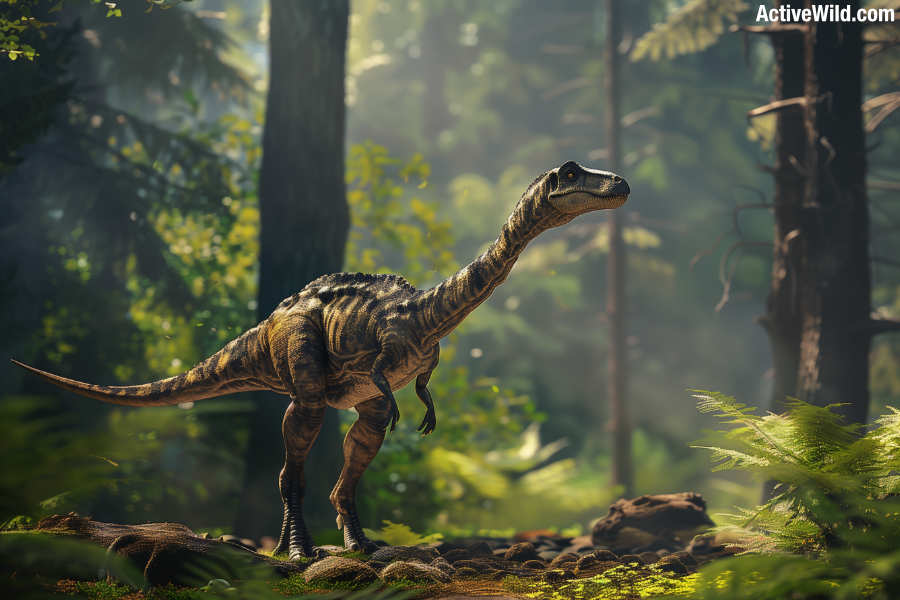Saturnalia is one of the earliest-known dinosaurs, and an important species in understanding the early evolution of sauropodomorphs – a group of dinosaurs that would eventually become some of the largest land animals the world has ever seen.
Although small, this Triassic period dinosaur had features linking more primitive dinosaurs to the later, more massive sauropods, such as Apatosaurus, Brachiosaurus, and other Mesozoic giants.
Read on to find out more about this fascinating dinosaur…
Page Index
Saturnalia Facts
- Type of Dinosaur: Basal sauropodomorph (early relative of the sauropods).
- Diet: Saturnalia was primarily an herbivore, though it may have had omnivorous tendencies based on its dental structure.
- Continent(s) Found: South America (Brazil).
- Length: Approximately 1.5 meters (5 feet)
- Weight: Estimated to weigh around 10-20 kilograms (22-44 pounds)
- Period: Late Triassic period, approximately 225 million years ago.
What Did Saturnalia Look Like?


Saturnalia was a relatively small dinosaur with a slender body and long neck and tail. It weighed around the same as a cocker spaniel.
Its head was small with a pointed snout, and it had sharp, leaf-shaped teeth suggesting a primarily herbivorous diet, potentially with omnivorous tendencies. Its large nostrils were characteristic of the sauropodomorphs.
The limbs of Saturnalia were fairly long, with the hind limbs being longer than the forelimbs. It was bipedal, walking on its hind legs.
Key Features:
- Head: Small with a pointed snout and sharp, leaf-shaped teeth
- Neck: Long and slender
- Body: Slender and elongated
- Tail: Long and likely used for balance
- Limbs: Hind limbs longer than forelimbs, indicating bipedal movement
Saturnalia’s appearance suggests it was well-adapted for a mixed diet and could move efficiently in its environment, likely using its long limbs to forage for plants and potentially small animals or insects.
What Type Of Dinosaur Was Saturnalia?


Saturnalia was a basal sauropodomorph. This classification places it among the early relatives of the later, more massive sauropods, which include dinosaurs like Brachiosaurus and Diplodocus.
Basal sauropodomorphs are some of the earliest known members of the group that would eventually give rise to the giant long-necked dinosaurs, making Saturnalia an important species for understanding the early evolution of this lineage.
Only one Saturnalia species has so far been identified: Saturnalia tupiniquim.
What Does The Name Saturnalia Mean?
The dinosaur was named Saturnalia because its discovery was made in Brazil around the time of the Saturnalia festival, a celebration in honor of the god Saturn.
Where Did Saturnalia Live?
Saturnalia lived in what is now South America. Its fossils have been found in the Santa Maria Formation in southern Brazil.
During the Late Triassic period, approximately 225 million years ago, this region would have been part of the supercontinent Pangaea, featuring a diverse array of environments including rivers, floodplains, and forests, which would have provided a suitable habitat for a small herbivorous or omnivorous dinosaur like Saturnalia.
When Did Saturnalia Live?
Saturnalia lived during the Late Triassic period, approximately 225 million years ago. This era, part of the Mesozoic Era, was characterized by the early diversification of dinosaurs and the presence of other prehistoric reptiles, amphibians, and early mammals.
The Late Triassic period was a time of significant ecological change and the emergence of many of the major groups of dinosaurs that would dominate the Mesozoic Era.
What Dinosaurs And Other Animals Did Saturnalia Live With?
During the Late Triassic period, Saturnalia lived alongside a variety of other dinosaurs and prehistoric animals.
Dinosaurs:
- Staurikosaurus: Found in the same region as Saturnalia, Staurikosaurus was a small, bipedal carnivore.
- Eoraptor: Considered one of the earliest known dinosaurs, Eoraptor was a small, omnivorous dinosaur that lived in what is now Argentina.
- Herrerasaurus: A large theropod dinosaur that was one of the top predators of its time in South America.
Other Prehistoric Animals:
- Rhynchosaurs: Herbivorous reptiles with beak-like mouths, which were abundant during the Triassic.
- Aetosaurs: Armored reptiles that were herbivores and resembled modern-day crocodiles.
- Cynodonts: Mammal-like reptiles that were part of the lineage leading to modern mammals.
- Phytosaurs: Large, crocodile-like reptiles that were semi-aquatic and likely top predators in their environments.
- Dicynodonts: Herbivorous, tusked reptiles that were among the most successful synapsids of the Triassic.
The Late Triassic was a time of great ecological diversity and the early stages of dinosaur evolution, with various forms of life coexisting and competing in a dynamic environment. Saturnalia would have been part of a complex ecosystem, interacting with both dinosaurs and other prehistoric animals.
Discover More About Dinosaurs With Active Wild
You can see more Triassic dinosaurs on this page: Triassic Dinosaurs
You can see a list of Triassic Animals on this page: Triassic Animals (That Weren’t Dinosaurs)

